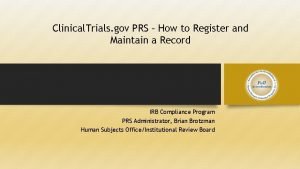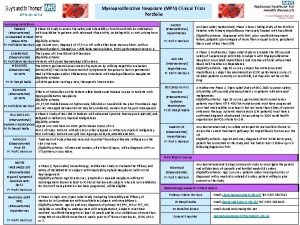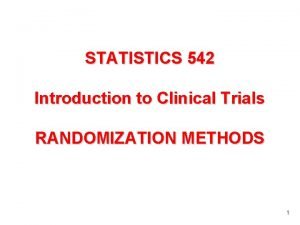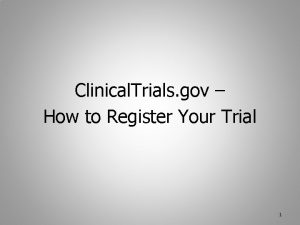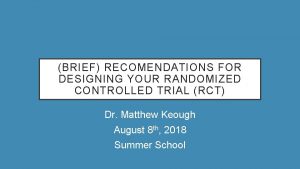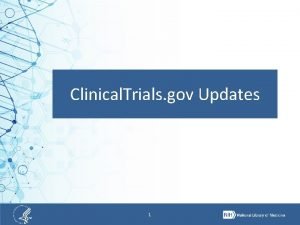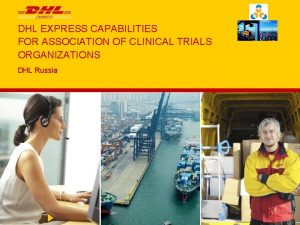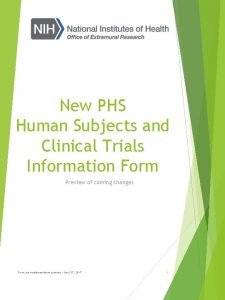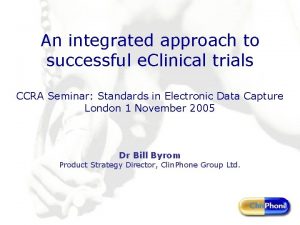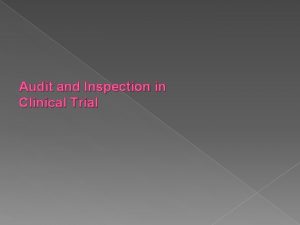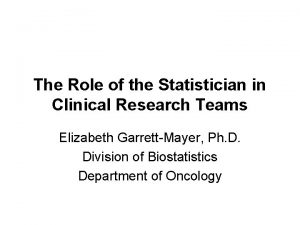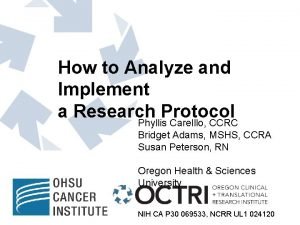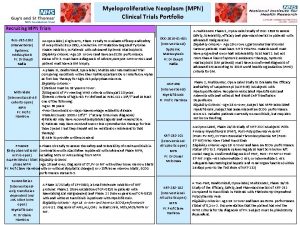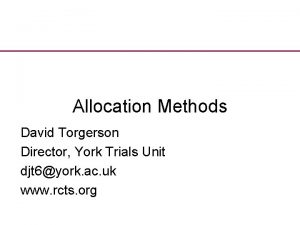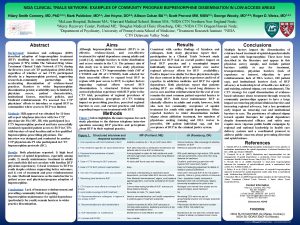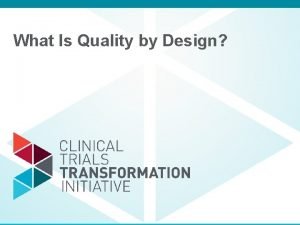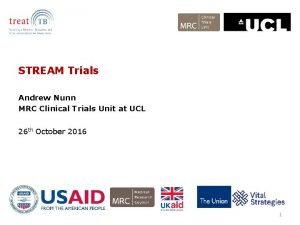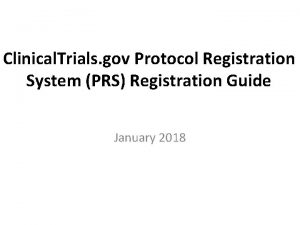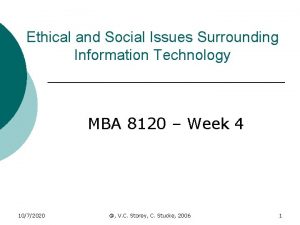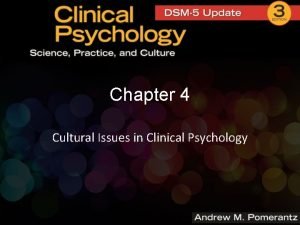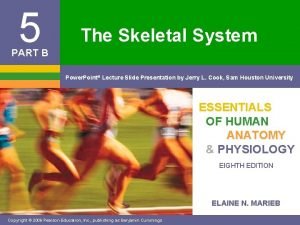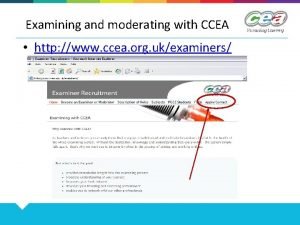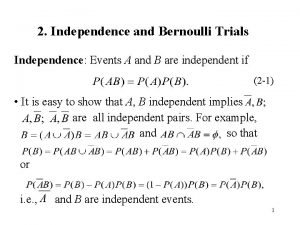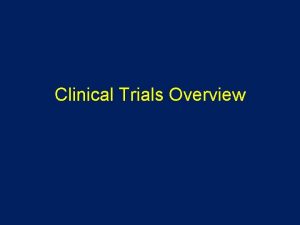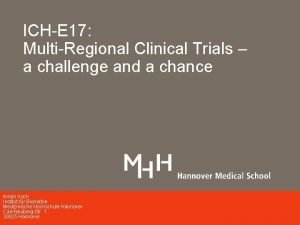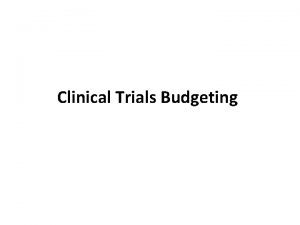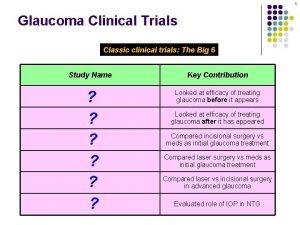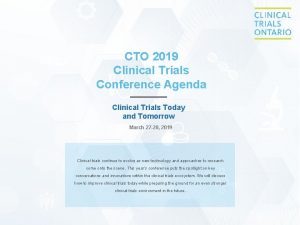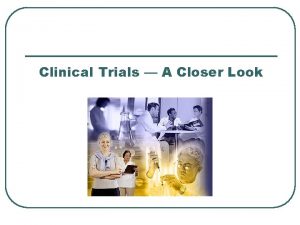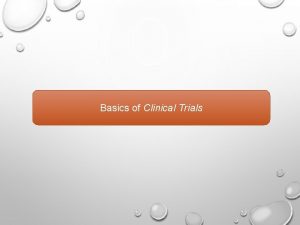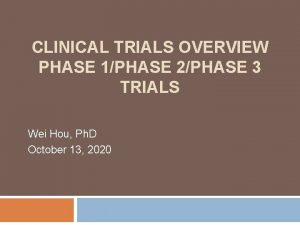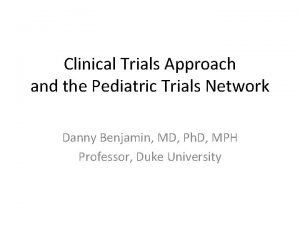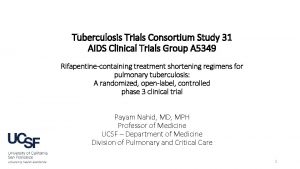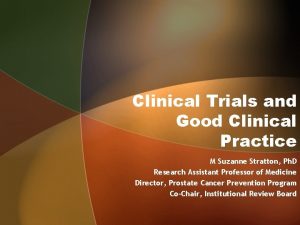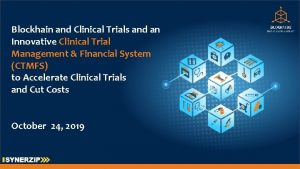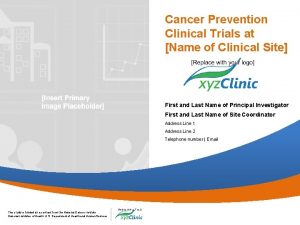An Overview of Issues Surrounding MultiRegional Clinical Trials
















































- Slides: 48

An Overview of Issues Surrounding Multi-Regional Clinical Trials Bruce Binkowitz Merck & Co. binkowitz@merck. com May 28, 2009 Merck

Introduction As of early 2008, there were 50, 629 clinical trials ongoing globally • up by 1. 3% over 2007 • Bio-IT World “Clinical Trials in new Europe”, by Al Doig, Jan-Feb issue 2009 Further reading: European clinical Trial Site Options: An Insider’s Analysis by PAvle Vukojevic, Nov 2008 www. Insight. Phrarm. Reports. com Merck

Global Trials: Challenges and Opportunities Merck

Guidances, Literature and the News • • Globalization of clinical trials is a reality. Clinical trials across multiple regions of the world have become common practice. Multi-regional trials (MRCT) have benefits but also come with a set of challenges. FDA/Ph. RMA Workshop: Challenges & Opportunities of Multi-regional Clinical Trials, Bethesda, MD October 29 -30, 2007 Merck

Guidances, Literature and the News • • FDA/Ph. RMA Workshop: Challenges & Opportunities of Multiregional Clinical Trials, Bethesda, MD October 29 -30, 2007 The focus of the workshop was to cover the opportunities and challenges presented by these trials. The workshop brought together representatives from industry, regulatory agencies and academia, who shared their experiences, perspectives and expertise This is not a new issue, but it is now more important and public than ever. Merck

Guidances, Literature and the News • ICH E 5 guideline was adopted in 1998 (update 2006) with the purpose to facilitate the registration of medicinal products among different geographic regions by recommending a framework for evaluating the impact of ethnic factors upon the efficacy or safety of a product. • ICH E 3 mentions reporting results by investigator site and suggests examining interactions and outliers. Merck

Guidances, Literature and the News • ICH E 9 discusses multi-center studies – but can this be extrapolated to multi-regional studies? • EMEA REFLECTION PAPER ON THE EXTRAPOLATION OF RESULTS FROM CLINICAL STUDIES CONDUCTED OUTSIDE EUROPE TO THE EU-POPULATION (2009): the aim of this reflection paper is to highlight some current experience from pivotal clinical studies conducted outside the EU region and to discuss how different factors (in particular extrinsic factors) may complicate the evaluation of foreign data in a European perspective. Merck

Guidances, Literature and the News • Basic Principles on Global Clinical Trials. (PFSB/ELD) Notification No. 0928010 dated Sept. 28, 2007. (Japan Guidance) • Kawai N, Chuang-Stein C, Komiyama O and Li Y. An approach to rationalize partitioning sample size into individual regions in a multiregional trial. Drug Information Journal 2007; 42: 139 -147. • Hui Quan, Peng-Liang Zhao, Ji Zhang, Martin Roessner and Kyo Aizawa Sample size considerations for Japanese patients in a multi-regional trial based on MHLW guidance, accepted for publication in Pharmaceutical Statistics Merck

Guidances, Literature and the News Merck

Guidances, Literature and the News Merck

Guidances, Literature and the News Drug Information Journal: • 1998 DIJ Vol 32, supplemental issue: Current Status of Clinical Trials in the Asia Pacific Region • 2003 DIJ Vol 37, supplemental issue: Global New Drug Development and the International Conference on Harmonzation in Asia • 2009 DIJ (Vol. 43. ) “Good Regulatory Science in Asia/Pacific: Parts 1 & 2” Merck

Guidances, Literature and the News The Wall Street Journal (12/1/08, Wang, et al. ) reports: • Western pharmaceutical companies are facing intensifying scrutiny over the conduct of clinical trials in developing countries -- an increasingly important source of patients to test new drugs. • Among the benefits of conducting trials in lower-income countries are the decreased cost and faster patient recruitment. • Moreover, in countries where access to medical care is poor, people are often desperate to participate in trials. • But, one concern is that "locals who carry out the work may feel pressure to cut corners to boost enrollment or reconcile questionable data”. Merck

Guidances, Literature and the News • FDA/Ph. RMA Workshop: Challenges & Opportunities of Multiregional Clinical Trials, Bethesda, MD October 29 -30, 2007 • Ph. RMA MRCT Cross-Functional Key Issues Team Merck

MRCT Cross-Functional Key Issues Team Created under the auspices of the Ph. RMA Biostatistical and Data Management Technical Group (BDMTG) and the Ph. RMA Clinical Leadership Committee (CLC) • • • A broad, ground level focus Resource to BDMTG, CLC as well as SGD, CRTG, RACC Multi-functional and worldwide in composition Statistics Epidemiology Data Management Regulatory Affairs Clinical Research Merck

Simultaneous Global Development • • ICH E-5 (February, 1998, clarifying document June, 2006) MHLW guidance (September, 2007) FDA/Ph. RMA MRCT Workshop (November, 2007) Tripartite Health Ministers Agreement (China, Korea, and Japan) and the East Asia Pharmaceutical Regulatory Symposium (EAPRS: Tokyo April, 2008) Merck

MRCT Cross-Functional Key Issues Team • Scope: Identify and address issues directly relevant to the efficient conduct of MRCT and the generation of data readily acceptable to regulatory authorities. Such issues can fall into 5 broad categories (no implied hierarchy here): • Statistical • Clinical • Operational • Regulatory • Ethical Merck

MRCT Cross-Functional Key Issues Team • • 2009 objective: get the word out, get involved, get informed, begin work on issues. 2009 DIA, SCT, JSM, FDA/Industry Workshop, Harvard-SP, MRCT Conference in Korea (June 2009 http: //www. apec-ahc. org/), special issue of Pharm. Stats Journal in 2010 Collect case studies and examples of MRCTs Develop a Survey of Ph. RMA 2010 and beyond: Workstreams leading to publications and presentations Broad Objective: Data driven. All suggestions welcome! Merck

MRCT Cross-Functional Key Issues Team • • • Underlying theme of all issues goes to quality and integrity of a trial. Clinical Trialists need to be acutely aware of the quality and integrity of the trial. Not just the quality and integrity of the data. Design a MRCT trial keeping the 5 areas of impact SCORE in mind. Merck

Areas of Impact: Ethical • Adequacy of protection of research subjects (e. g. NEJM Glickman, et. al. ) • Informed Consent (e. g. Annas in NEJM, 14 May 2009) • Integrity of research conduct • • • Ease of access Transparency of the research Quality of the review that permits the conduct of the research • Local Ethics Committees, IRB’s, etc. • Data collection/privacy • Above true in general Merck

Areas of Impact: Ethical • Need to conduct a MRCT according to Good Clinical Practice Standards • Relevant country and local statutes regarding: • • Regs regarding ethical committee reviews Informed consent Withdrawn consent Protection of human patients participating in biomedical research. Merck

MRCT Areas of Impact: Clinical From the EU Reflection Paper Merck

MRCT Areas of Impact: Clinical Extrinsic versus Intrinsic factors • Lack of quality data showing the comparabiilty of PK/PD relationships among different ethnic/racial groups, or among “regions”. • “A Review and Assessment of Potential Sources of Ethnic Differences in Drug Responsiveness”, Thorir D. Bjornsson, et. al. 2003: 43: 943 -967, The Journal of Clinical Pharmacology. “An extensive review of the world literature on ethnic differences in drug disposition and responsiveness. ”, the Ph. RMA CPTG group. Merck

MRCT Areas of Impact: Clinical • Medical practice • Differences in standard of care with markedly varied medical practice, including disease defintions • Differences in access to the regional healthcare system • Differences in criteria for hospitalization and treatment • Concomitant medications • Differences in diet, smoking, alcohol • • Placebo responses Cultural differences • AE reporting and evaluation • Endpoints PRO (i. e. more subjective endpoints). Merck

MRCT Areas of Impact: Clinical Example from the EU Reflection Paper - Antithrombotic Agents “The main factors that complicated the extrapolation of data between different geographical areas (North America versus Europe, China versus Europe, Eastern versus Western Europe) were differences in medical practice, such as co-medications, rate of revascularization and duration to treatment start. ” Merck

Areas of Impact: Operational • • Challenges when moving from phase II to phase III to post-marketing (e. g. expanding # of sites, regions. What about flexible designs? ) Language and translations Local versus regional versus central labs • Shipping • Normal ranges • Quality Control, assay validation SOPs and Manuals, including Global Clinical SOPs, data handling SOPs, operational SOPs (translations, training, “help desk”) Merck

Areas of Impact: Operational • Technological standards / telecommunication bandwidth Multi-regional trial versus multiple regional trials Enrollment, access to the appropriate patient population Drug Supply, IVRS, Randomization • Trial Quality and Integrity • • • Merck

Areas of Impact: Operational • Trial Quality and Integrity is this, and more: • Metrics: how do we measure quality and integrity? Is QA separate from QC, e. g. the quality assurance audits of the QC activities to ensure compliance to GCP, company policies, etc • • Investigator training Quality Assurance Data management and data quality Who’s looking at the data for a MRCT? Sponsor? CRO? (QC of on-site monitoring, AE reporting) • Plan in the protocol for sources of heterogeneity – adjust the sample size as needed. Merck

Areas of Impact: Regulatory • • • Dealing with differing (and possibly opposing) regulatory requirements • Including differing primary and secondary endpoint requirements • Divergence in the requirements for the control arm, in clinical studies EU vs. US vs. Asia. Obtaining agreement from differing health authorities Level of evidence needed • Based on the studies • Based on the health authority resources (reliance on other health authorities) Merck

Areas of Impact: Regulatory • • • Handling different regulatory review and approval times when trying to orchestrate a simultaneous global submission. Managing and responding to requests across multiple agencies Determining the acceptability of MRCT data Merck

Areas of Impact: Regulatory Illustrative Example • On April 5, 2006, Health Canada adopted the following two International Conference on Harmonisation (ICH) guidances: • ICH S 7 B: The Non-Clinical Evaluation of the Potential for Delayed Ventricular Repolarization (QT Interval Prolongation) by Human Pharmaceuticals • ICH E 14: The Clinical Evaluation of QT/QTc Interval Prolongation and Proarrhythmic Potential for Non-Antiarrhythmic Drugs • On November 30, 2006, Health Canada adopted the following regional guidance documents to support the interpretation and implementation of the ICH guidances: • Health Canada Question and Answer Document Regarding the ICH S 7 B and E 14 Guidances • Guide for the Analysis and Review of QT/QTc Interval Data (comments until June 10, 2009) • QT/QTc Interval Prolongation: Guidance for Product Monograph Content Merck

Areas of Impact: Statistical • Importance of predefining the definition of region • Lab data – local, regional, central Merck

Areas of Impact: Statistical • • Impact of regional differences on power estimation / sample size Methods for subgroup analysis Randomization issues (and drug supply) / stratification How to describe/present data by region Merck

Areas of Impact: Statistical • • • Adaptive/flexible designs in a MRCT setting Imbalances in region sizes (planned and unplanned) Use of placebo / placebo effects Acceptability of non-inferiority vs. superiority studies – regional acceptability? Lack of consensus of the non-inferiority margins? Differences in Health Authority preferences. Drug approved in countries with different dosing regimens – can you still use MRCT? Or multiple trials in different regions? Merck

Areas of Impact: Statistical • Multi-regional trial versus multiple regional trials – a single pivotal trial? Prep for ISE? Subgroups? Pooling/meta-analysis/integration of efficacy data. • Define consistency of treatment effect (not just by a statistical interaction test) • Fixed versus random effects Merck

Brief Examples of MRCT Issues

Everest Merck

EVEREST • • In EVEREST, patients hospitalized for acute heart failure (HF) with systolic dysfunction on standard therapy were randomized to tolvaptan or placebo. The EVEREST program demonstrated that the oral vasopressin antagonist, tolvaptan, added to standard therapy, improved some, but not all, HF signs and symptoms during hospitalization over placebo; it showed no effect on long-term mortality or HF-related morbidity Merck

EVEREST post-hoc analysis: Merck

EVEREST post-hoc analysis author’s summary: • • • The publication yields data demonstrating that despite efforts to select for a fairly homogenous study population (i. e. a protocol), important differences in etiology, severity, management, and outcomes existed. The etiology and management of HF may vary by region and is difficult to control. Future AHFS trials should take these continental and regional differences into consideration and possibly stratify randomization based on continent or region when appropriate and analyze the data separately. Merck

Statistical Issues: MHLW guidance • • The Japanese regulatory authority: Ministry of Health, Labour and Welfare (MHLW), ‘Basic Principles on Global Clinical Trials’ guidance Provides basic concepts for planning and implementing MRCTs using a Q&A format One point specifically addresses a need to determine the number of Japanese patients. Does not recommend any single method for determining sample sizes to establish the consistency of treatment effects for the entire group versus the Japanese group BUT, it does provide two methods as examples. Kawai et al. discuss sample size consideration for Method 2. Quan et. al. discuss sample size considerations for Method 1. Merck

Example for A Placebo-controlled Study Using Quantitative Measurements • Method 1 • Dall: difference in entire population • DJ: difference in subgroup of patients enrolled from Japan • P(DJ / Dall >π) ≥ 80%, for example π = 0. 5 DJ ( >πDall ) Dall 0 Efficacy Merck

Example for A Placebo-controlled Study Using Quantitative Measurements • Method 2 • Dall: difference in entire population • D 1 , D 2 , D 3 : differences in subgroup of region 1, 2, 3, respectively, in the case of three regions • P(D 1 >0, D 2 >0, D 3 >0 | Dall>0) ≥ say, 80% Dall D 1 D 2 D 3 0 Efficacy Merck

Method 1 Method 2 Statistics Point estimate Criterion DJ / Dall >π D 1 >0, D 2 >0, D 3 >0 (3 region example) when Dall>0 Properties Focuses on Japan. Prob. of meeting requirement increases as % Japanese Treats regions symmetrically. Prob. of meeting requirement reaches maximum when regions have equal sample size pts increases Remaining Issues Value of π Definition of region. Number of regions. Is Japan the only interesting region? DJ>0 | Dall>0 Slides on methods 1, 2 courtesy of Y. Song of Merck

MLHW Consistency in Trends Approach • • Overall sample size determined to provide 80% or 90% power at 1 sided 0. 025 level Sample size in the smallest region determined by ensuring the probability of observing consistent trends (in point estimates) across all concerned regions is 80% (90%) Merck

Conditional Consistency • Sample size in the smallest region needs to ensure the probability of observing consistent trends (in point estimates) across all concerned regions is 80% (90%) conditional on the overall treatment effect is significant • A less conservative approach: smaller sample size requirement for the smallest region • (Simple) Simulation is usually needed for computation Merck

Summary • • When thinking of designing and conducting a clinical trial, those responsible for the conduct of the trial must consider the ethical, clinical, operational, regulatory and statistical issues. This is never more true than when planning, conducting, analyzing and interpreting a trial that covers multiple regions. Merck

The Ph. RMA Cross-Functional Key Issues Membership: Ibia, Ekopimo Merck Ikeda, Kimitoshi Novartis Binkowitz, Bruce Merck Chen, Joshua Merck Saillot, Jean-Louis Schering-Plough Cindy, Girman Merck Tanaka, Yoko X 1 Eli Lilly & Co Menjoge, Shailendra Boehringer Ingelheim Talerico, Steven D Schering-Plough Fedorov, Valerie V Glaxo. Smith. Kline Lee, Andy Pfizer Ouyang, S. Peter Celgene Field, Belinda Pfizer Ferreira, Irene Amgen Li, Gang J&JPRD Langley, Michael Eli Lilly & Co Houck, Tonya Pfizer Quan, Hui Sanofi-Aventis Schiff, Kenneth Hoffman La. Roche Rabbia, Michael Roche Battles, Mary Ann Amgen Ohishi, Masahiko Merck Luo, Xiaolong Celgene Gallo, Paul Novartis Merck

Thank You! Questions?
 Hawk irb
Hawk irb Site initiation visit ppt
Site initiation visit ppt Professor claire harrison
Professor claire harrison Randomization
Randomization Clinical trials.gov login
Clinical trials.gov login Clinical trials
Clinical trials Clinical trials gov api
Clinical trials gov api Dhl clinical trials
Dhl clinical trials Phs human subjects and clinical trials information
Phs human subjects and clinical trials information Fsfv clinical trial
Fsfv clinical trial Difference between inspection and audit
Difference between inspection and audit Role of statistician in clinical trials
Role of statistician in clinical trials Ohsu clinical trials office
Ohsu clinical trials office Clinical hysteria salem witch trials
Clinical hysteria salem witch trials Mpn clinical trials
Mpn clinical trials York trials unit
York trials unit Nida clinical trials network
Nida clinical trials network Clinical trials quality by design
Clinical trials quality by design Andrew nunn
Andrew nunn Prs registration
Prs registration Issues surrounding information privacy
Issues surrounding information privacy What ethical issues surrounding executive compensation
What ethical issues surrounding executive compensation Cultural issues in clinical psychology
Cultural issues in clinical psychology Chapter 5 the skeletal system figure 5-10
Chapter 5 the skeletal system figure 5-10 Surrounding
Surrounding Suez canal in asia map
Suez canal in asia map Italy bordering countries
Italy bordering countries A thin layer of gases surrounding earth
A thin layer of gases surrounding earth Surrounding
Surrounding Double layered membrane that covers the lungs
Double layered membrane that covers the lungs Countries surrounding brazil
Countries surrounding brazil Perceptual region
Perceptual region Axial skeleton chapter 5 the skeletal system
Axial skeleton chapter 5 the skeletal system Surrounding net
Surrounding net The part of a shadow surrounding the darkest part
The part of a shadow surrounding the darkest part Balkan peninsula ancient greece map
Balkan peninsula ancient greece map Ccea agreement trials
Ccea agreement trials Repeated bernoulli trials
Repeated bernoulli trials National geographic salem witch trials
National geographic salem witch trials Ndsu corn variety trials
Ndsu corn variety trials How is the crucible unlike the salem witch trials?
How is the crucible unlike the salem witch trials? 6 trials of jesus
6 trials of jesus Future search trials austin
Future search trials austin Random control trials
Random control trials Do these situations involve bernoulli trials
Do these situations involve bernoulli trials Malta football trials
Malta football trials What was rebecca nurse reputation in the community
What was rebecca nurse reputation in the community Design and analysis of cross-over trials
Design and analysis of cross-over trials Do we our life done
Do we our life done
